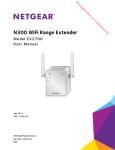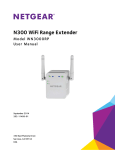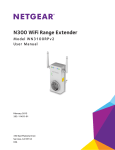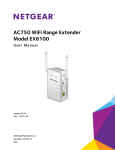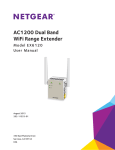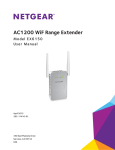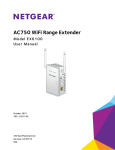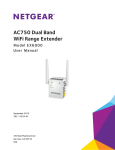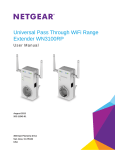Download Netgear EX2700-100PES
Transcript
N300 WiFi Range Extender Model E X2700 User Manual July 2014 202-11395-01 350 East Plumeria Drive San Jose, CA 95134 USA N300 WiFi Range Extender Support Thank you for selecting NETGEAR products. After installing your device, locate the serial number on the label of your product and use it to register your product at https://my.netgear.com. You must register your product before you can use NETGEAR telephone support. NETGEAR recommends registering your product through the NETGEAR website. For product updates and web support, visit http://support.netgear.com. Phone (US & Canada only): 1-888-NETGEAR. Phone (Other Countries): Check the list of phone numbers at http://support.netgear.com/general/contact/default.aspx. Compliance For regulatory compliance information, visit http://www.netgear.com/about/regulatory. See the regulatory compliance document before connecting the power supply. Trademarks NETGEAR, the NETGEAR logo, and Connect with Innovation are trademarks and/or registered trademarks of NETGEAR, Inc. and/or its subsidiaries in the United States and/or other countries. Information is subject to change without notice. © NETGEAR, Inc. All rights reserved. 2 N300 WiFi Range Extender Contents Chapter 1 Get to Know Your Extender Meet Your Extender . . . . . . . . . . . . . . . . . . . . . . . . . . . . . . . . . . . . . . . . . . . . . . . . . . 5 How the Extender Works . . . . . . . . . . . . . . . . . . . . . . . . . . . . . . . . . . . . . . . . . . . . . . 6 When to Use Your Extender . . . . . . . . . . . . . . . . . . . . . . . . . . . . . . . . . . . . . . . . . . . . 6 Chapter 2 Install Your Extender Place the Extender and Apply Power . . . . . . . . . . . . . . . . . . . . . . . . . . . . . . . . . . . . 8 Connect to an Existing WiFi Network . . . . . . . . . . . . . . . . . . . . . . . . . . . . . . . . . . . . 8 Extender WiFi Performance . . . . . . . . . . . . . . . . . . . . . . . . . . . . . . . . . . . . . . . . . . . 11 Cable a Computer or Device to the Ethernet Port . . . . . . . . . . . . . . . . . . . . . . . . 11 Chapter 3 Manage the Extender Network and Settings Log In to the Extender After Initial Setup . . . . . . . . . . . . . . . . . . . . . . . . . . . . . . . 14 Change the admin Password . . . . . . . . . . . . . . . . . . . . . . . . . . . . . . . . . . . . . . . . . . 14 Use the Setup Wizard to Connect the Extender to a Network. . . . . . . . . . . . . . 15 Add a WPS Client to the Extender Network . . . . . . . . . . . . . . . . . . . . . . . . . . . . . 17 View or Change Wireless Settings . . . . . . . . . . . . . . . . . . . . . . . . . . . . . . . . . . . . . 17 View or Change Advanced Wireless Settings . . . . . . . . . . . . . . . . . . . . . . . . . . . . 18 Set Up a Wireless Access List . . . . . . . . . . . . . . . . . . . . . . . . . . . . . . . . . . . . . . . . . . 19 Set Up the Extender to Use a Static IP Address . . . . . . . . . . . . . . . . . . . . . . . . . . 21 Chapter 4 Monitor and Maintain the Extender Back Up the Extender Configuration . . . . . . . . . . . . . . . . . . . . . . . . . . . . . . . . . . . 23 Restore Saved Configuration Settings . . . . . . . . . . . . . . . . . . . . . . . . . . . . . . . . . . 23 Return the Extender to Its Factory Settings . . . . . . . . . . . . . . . . . . . . . . . . . . . . . 24 Use the Factory Reset Button to Restore Factory Settings . . . . . . . . . . . . . . 24 Erase the Extender Settings and Return to Factory Settings . . . . . . . . . . . . . 25 Upgrade the Firmware . . . . . . . . . . . . . . . . . . . . . . . . . . . . . . . . . . . . . . . . . . . . . . . 26 View Wired and Wireless Network Devices . . . . . . . . . . . . . . . . . . . . . . . . . . . . . . 27 Chapter 5 FAQs and Troubleshooting FAQs. . . . . . . . . . . . . . . . . . . . . . . . . . . . . . . . . . . . . . . . . . . . . . . . . . . . . . . . . . . . . . . 30 Cannot Log In to the Extender . . . . . . . . . . . . . . . . . . . . . . . . . . . . . . . . . . . . . . . . 31 Cannot Join the Extender WiFi Network . . . . . . . . . . . . . . . . . . . . . . . . . . . . . . . . 32 Appendix A Supplemental Information Factory Default Settings . . . . . . . . . . . . . . . . . . . . . . . . . . . . . . . . . . . . . . . . . . . . . 34 Technical Specifications . . . . . . . . . . . . . . . . . . . . . . . . . . . . . . . . . . . . . . . . . . . . . . 34 3 1. Get to Know Your Extender 1 This chapter covers the following topics: • Meet Your Extender • How the Extender Works • When to Use Your Extender For more information about the topics covered in this manual, visit the support website at http://support.netgear.com. Firmware updates with new features and bug fixes are made available from time to time on downloadcenter.netgear.com. Some products can regularly check the site and download new firmware, or you can check for and download new firmware manually. If the features or behavior of your product does not match what is described in this guide, you might need to update your firmware. 4 N300 WiFi Range Extender Meet Your Extender LEDs are located on the front panel. Buttons are located on the side panel. The Factory Reset button and an Ethernet port are located on the bottom. Router Link LED Device Link LED Power LED WPS LED Power On/Off button WPS button Factory Reset button Ethernet port Figure 1. Extender front panel Table 1. LEDs LED Description Router Link LED The connection between the extender and the router or access point: • Solid green. Best connection. • Solid amber. Good connection. • Solid red. Poor connection. • Off. No connection. Device Link LED The connection between the extender and a computer or mobile device. • Solid green. Best connection. • Solid amber. Good connection. • Solid red. Poor connection. • Off. No connection. Power LED • • • Solid amber. The extender is booting. Solid green. The extender is powered on. Off. The extender is powered off. WPS LED • • • Solid green. WiFi security is enabled (WPA or WPA2). Blinking green. A WPS connection is being established. Off. WiFi security is not enabled. Get to Know Your Extender 5 N300 WiFi Range Extender How the Extender Works The extender increases the distance of a WiFi network. The extender connects to your network’s WiFi signal and it broadcasts its own WiFi signal. When you are too far away to connect to your network’s WiFi signal, you can connect to an extender WiFi signal instead. WiFi Range Extender Boosts the range of your existing WiFi and creates a stronger signal in hard-to-reach areas. Existing WiFi Sometimes your router does not provide the WiFi coverage you need. Figure 2. The extender WiFi signals reach areas outside the range of your router When to Use Your Extender NETGEAR recommends that you connect to the extender only when your WiFi network connection is poor. Data traffic routed through the extender is inherently slower than traffic routed directly from the network. Get to Know Your Extender 6 2. 2 Install Your Extender This chapter covers the following topics: • Place the Extender and Apply Power • Connect to an Existing WiFi Network • Extender WiFi Performance • Cable a Computer or Device to the Ethernet Port 7 N300 WiFi Range Extender Place the Extender and Apply Power NETGEAR recommends that you place the extender near the router during initial setup. Then move it farther away from the router as needed to increase the area that receives a WiFi signal. To place the extender and apply power: 1. Place your extender in the same room as your WiFi router. 2. Plug the extender into an electrical outlet. The Power LED lights green. If the Power LED does not light, press the Power button. Connect to an Existing WiFi Network To extend the range of your WiFi network, you must connect the extender to your existing WiFi network. You can connect with WPS or with NETGEAR genie Smart Setup. Connect with WPS Wi-Fi Protected Setup (WPS) lets you connect the extender to a secure WiFi network without typing the network name and password. The WPS button is a physical button on the router or access point. WPS does not support WEP network security. If you are using WEP security, see Connect with NETGEAR genie Smart Setup on page 9. To connect with WPS: 1. Press the WPS button on the side panel of the extender. The WPS LED blinks. 2. Within two minutes, press the WPS button on your router or access point. The WPS LED on the extender lights solid green, the Router Link LED the extender is connected to your existing WiFi network. lights, and does not light, try again. If it still does not Note: If the Router Link LED light, see Connect with NETGEAR genie Smart Setup on page 9. 3. On your computer or wireless device, find the new extender network name. The extender’s wireless network name (SSID) changes to your existing WiFi network name, with _EXT at the end of the name. For example: • Existing WiFi network name. MyNetworkName • New extended network name. MyNetworkName_EXT Install Your Extender 8 N300 WiFi Range Extender 4. Connect your existing WiFi devices to the new extended network. Use the same WiFi password that you use for your WiFi router. 5. Unplug the extender and move it to a new location closer to the area with a poor WiFi signal. The location that you choose must be within the range of your existing WiFi router network. 6. Plug the extender into an electrical outlet and wait one minute. The Power LED lights green. If the Power LED does not light, press the Power button. 7. Use the Router Link LED connection is optimal. to help you choose a spot where the extender-to-router Connect with NETGEAR genie Smart Setup You can use a web browser to connect to the extender and set it up. To connect with the browser-based Smart Setup: 1. Use a WiFi network manager on a computer or mobile device to find and connect to the extender WiFi network. After the connection with the computer or mobile device is established, the Device Link LED lights solid green. 2. Open a web browser window from the same computer or mobile device. The browser takes you directly to NETGEAR genie Smart Setup. Note: If you are not automatically directed to NETGEAR genie, launch a web browser and enter www.mywifiext.net in the address field. Enter admin for the user name and password for the password. 3. Select a WiFi network to extend and click the Continue button. 4. In the Password field, type the network password (also called passphrase or security key) and click the Continue button. Install Your Extender 9 N300 WiFi Range Extender 5. In the Name field, type a name (SSID) for your new extender WiFi network and click the Continue button. Note: You can use the same security settings as your existing network by selecting the check box. The settings are applied and the following screen displays: 6. Use a WiFi network manager on the computer or mobile device to connect to the extender’s newly created WiFi network. 7. Enter your password. 8. Select the check box and click the Continue button. Install Your Extender 10 N300 WiFi Range Extender 9. Unplug the extender and move it to a new location closer to the area with a poor WiFi signal. The location you choose must be within the range of your existing WiFi router network. 10. Plug the extender into an electrical outlet and wait one minute. The Power LED button. lights green. If the Power LED does not light, press the Power 11. Use the Router Link LED connection is optimal. to help you choose a spot where the extender-to-router Extender WiFi Performance The extender LEDs indicate the strength of the extender’s WiFi connections. Use the following table to understand the extender LEDs. Table 2. WiFi performance LEDs LED Description Router Link LED indicates the strength of the WiFi signal between the router and the extender. Device Link LED indicates the strength of the WiFi signal between the extender and the computer or mobile device. The LEDs are color coded as follows: • Green indicates the best connection. • Amber indicates a good connection. • Red indicates a poor connection. An LED that is off indicates no WiFi connection. Cable a Computer or Device to the Ethernet Port You can use an Ethernet cable to connect a computer or device to the Ethernet port on the extender. Here are some examples of when you might want to do this: • You want to use a computer to log in to the extender to view or change its settings, but you are experiencing trouble connecting to the extender WiFi networks. • You already installed the extender and now you want to connect a device to the extender’s Ethernet port. To cable a computer to the extender Ethernet port: 1. Install the extender so that it is connected to your existing network with a WiFi link. 2. Connect an Ethernet cable to the Ethernet port on the extender and to an Ethernet port on your computer. The computer connects to the extender. Your computer might display a message notifying you of an Ethernet connection. Install Your Extender 11 N300 WiFi Range Extender To cable a device to the extender Ethernet port: 1. Install the extender so that it is connected to your existing network with a WiFi link. 2. Connect an Ethernet cable to the Ethernet port on the extender and to an Ethernet port on your device. Extender Blu-ray player WiFi router The device connects to the extender. Now the device can access your existing network through the extender. Install Your Extender 12 3. Manage the Extender Network and Settings This chapter covers the following topics: • Log In to the Extender After Initial Setup • Change the admin Password • Use the Setup Wizard to Connect the Extender to a Network • Add a WPS Client to the Extender Network • View or Change Wireless Settings • View or Change Advanced Wireless Settings • Set Up a Wireless Access List • Set Up the Extender to Use a Static IP Address 13 3 N300 WiFi Range Extender Log In to the Extender After Initial Setup After installation, you can log in to the extender to view or change its settings. To log in to the extender after the initial setup: 1. Connect a computer or mobile device to the extender’s network. 2. Launch a web browser and enter www.mywifiext.net in the address field. A login screen displays. 3. Enter admin for the user name and password for the password. If your extender is connected to the Internet, the extender automatically checks for new firmware at the NETGEAR website. The Status screen displays. Change the admin Password The user name to access the extender is admin and its default password is password. NETGEAR strongly recommends that you set a more secure password. To change the password for the extender: 1. On your computer, launch a web browser. 2. In the address field of your browser, enter http://www.mywifiext.net. You are prompted to enter a user name and password. If you do not see the login prompt, make sure to include http:// when you type http://www.mywifiext.net in your browser. 3. Type admin for the user name and password for the password. Manage the Extender Network and Settings 14 N300 WiFi Range Extender If you already changed the password and want to change it again, type your personalized password. 4. Select Maintenance > Set Password. 5. Type the old password. 6. Type the new password twice. 7. Click the Apply button. Your settings are saved. Use the Setup Wizard to Connect the Extender to a Network The first time that you use a browser to connect to the extender to install it, the NETGEAR genie installation wizard displays. If you want to use a wizard to set up the extender again, you can log in to the extender and use the Setup Wizard. To use the Setup Wizard to connect the extender to a WiFi network: 1. On your computer, launch a web browser. 2. In the address field of your browser, enter http://www.mywifiext.net. You are prompted to enter a user name and password. If you do not see the login prompt, make sure to include http:// when you type http://www.mywifiext.net in your browser. 3. Type admin for the user name and password for the password. If you already changed the password, type your personalized password. 4. Select Setup Wizard. The extender finds the wireless networks in your area and displays a list. Manage the Extender Network and Settings 15 N300 WiFi Range Extender 5. To select the network you want the extender to join, do one of the following: • Select the radio button for the network. • Select the Manually input my wireless SSID radio button and type the name of the network. 6. Enter the security settings for the network that you selected. 7. Click the Continue button. You are prompted to name the extender network. By default, the extender network name is the same as the network that you selected with _EXT at the end. 8. Either change the name or leave it as is, and click the Continue button. The settings are applied to the extender. Note: You can use the same security settings used in your existing network by selecting the check box. The settings are applied and the following screen displays: 9. Use a WiFi network manager on the computer or mobile device to connect to the extender’s newly created WiFi network. 10. Enter your password. Your computer or wireless device connects to the network. Manage the Extender Network and Settings 16 N300 WiFi Range Extender Add a WPS Client to the Extender Network A WPS client is a computer or wireless device. WPS lets you add a wireless computer or device to the extender’s WiFi network without typing the WiFi password. WPS does not support WEP network security. If you are using WEP security, see Connect with NETGEAR genie Smart Setup on page 9. Note: For information about how to use the physical WPS button on the extender, see Connect with WPS on page 8. To add a WPS client: 1. Launch a web browser from a computer or wireless device that is connected to the network. 2. In the address field of your browser, enter http://www.mywifiext.net. A login screen displays. You are prompted to enter a user name and password. If you do not see the login prompt, make sure to include http:// when you type http://www.mywifiext.net in your browser. 3. Type admin for the user name and type your password. If you did not personalize your password, type password for the password. 4. Select Add WPS Client. 5. Click the Next button. 6. Select a setup method: • Push button. Click the WPS button on this screen. • PIN Number. The screen adjusts. Enter the client security PIN and click the Next button. 7. Within two minutes, go to the client device and use its WPS software to connect to the WiFi network. The WPS process automatically sets up your wireless computer with the network password when it connects. The extender WPS screen displays a confirmation message. View or Change Wireless Settings Changing the wireless settings disconnects all computers or wireless devices from the WiFi network. To reconnect to the WiFi network, you must use the new settings. To view or change the wireless settings: 1. On your computer, launch a web browser. 2. In the address field of your browser, enter http://www.mywifiext.net. Manage the Extender Network and Settings 17 N300 WiFi Range Extender You are prompted to enter a user name and password. If you do not see the login prompt, make sure to include http:// when you type http://www.mywifiext.net in your browser. 3. Type admin for the user name and type your password. If you have not yet personalized your password, type password for the password. 4. Select Setup > Wireless Settings. 5. To change the network name, type a name in the Name (SSID) field. 6. To change the region, select the correct region from the Region list. 7. To change the WiFi security, select a radio button in the Security Options section. 8. To save your settings, click the Apply button. If you changed the settings, the new settings take effect and computers and wireless devices on the network are automatically disconnected. View or Change Advanced Wireless Settings Use care when changing the wireless settings. Incorrect settings might disable the extender’s WiFi networks unexpectedly. To view or change the advanced wireless settings: 1. On your computer, launch a web browser. 2. In the address field of your browser, enter http://www.mywifiext.net. You are prompted to enter a user name and password. If you do not see the login prompt, make sure to include http:// when you type http://www.mywifiext.net in your browser. 3. Type admin for the user name and type your password. If you did not personalize your password, type password for the password. Manage the Extender Network and Settings 18 N300 WiFi Range Extender 4. Select Advanced > Wireless Settings. All the check boxes are selected by default. 5. In the Advanced Wireless Settings section of the screen, select or clear the check boxes. • Enable Wireless Access Point. When this check box is selected, the extender allows WiFi connections. Clearing this check box prevents wireless devices from connecting to the extender. LAN devices can still connect to the extender over an Ethernet cable. • Enable SSID Broadcast. When this check box is selected, the extender broadcasts its wireless network name (SSID). Clearing this check box hides the extender’s network name. In such a situation, this network name does not display in a WiFi network manager. A user who wants to join this hidden network must know its network name. • Keep Existing Wireless Settings. This check box is selected so that if you use WPS to connect to the extender WiFi network, its wireless network name stays the same instead of changing to a new, randomly generated network name. NETGEAR recommends that you leave this check box selected. 6. Click the Apply button. Your settings are saved. Set Up a Wireless Access List By default, any wireless device that is configured with the correct network name (SSID) can access the extender’s WiFi networks. For increased security, you can restrict access to the extender’s WiFi networks so that only wireless devices with the MAC addresses that you add to an access list can connect. Each network device is assigned a MAC address, which is a unique 12-character physical address, containing the hexadecimal characters 0–9, a–f, or A–F only, and separated by colons (for example, 00:09:AB:CD:EF:01). Typically, the MAC address is on the label of the wireless device. If cannot access the label, you can display the MAC address using the network configuration utilities of the computer. You might also find the MAC addresses on the Network Devices screen (see View Wired and Wireless Network Devices on page 27). Manage the Extender Network and Settings 19 N300 WiFi Range Extender CAUTION: If you use a wireless device to set up the access list, add your wireless device to the access list. Otherwise, you are disconnected when you click the Apply button. To avoid this situation, use a computer with a wired connection to access the extender. Before you enable the access list, you must add the MAC addresses of the wireless devices that you want to grant access to the WiFi network of the extender. To set up and enable the access list: 1. On your computer, launch a web browser. 2. In the address field of your browser, enter http://www.mywifiext.net. You are prompted to enter a user name and password. If you do not see the login prompt, make sure to include http:// when you type http://www.mywifiext.net in your browser. 3. Type admin for the user name and type your password. If you did not personalize your password, type password for the password. 4. Select Advanced > Wireless Settings and click the Setup Access List button. The Wireless Card Access List screen displays. 5. Click the Add button. The screen adjusts. 6. In the Device Name field, type a name for the wireless device. 7. In the MAC Address field, type the MAC address of the wireless device. 8. Click the Apply button. 9. Above the list, select the Turn Access Control On check box. Manage the Extender Network and Settings 20 N300 WiFi Range Extender 10. Click the Apply button. Now only computers and devices in the Wireless Card Access list can join the extender’s WiFi networks. Set Up the Extender to Use a Static IP Address By default, the extender gets its IP address dynamically from the router in your network. This is the most common setting and is suitable for most situations. You can set up the extender to use a static IP address. You specify the static IP address and it always stays the same. Working with a static IP address requires networking knowledge. To specify a static IP address: 1. On your computer, launch a web browser. 2. In the address field of your browser, enter http://www.mywifiext.net. You are prompted to enter a user name and password. If you do not see the login prompt, make sure to include http:// when you type http://www.mywifiext.net in your browser. 3. Type admin for the user name and type your password. If you did not personalize your password, type password for the password. 4. Select Setup > IP Address Setup. 5. Select the Use Static IP Address radio button. 6. Complete the static IP address fields. 7. Click the Apply button. Your settings are saved. Manage the Extender Network and Settings 21 4. Monitor and Maintain the Extender This chapter covers the following topics: • Back Up the Extender Configuration • Restore Saved Configuration Settings • Return the Extender to Its Factory Settings • Upgrade the Firmware • View Wired and Wireless Network Devices 22 4 N300 WiFi Range Extender Back Up the Extender Configuration When the extender works correctly after initial setup, NETGEAR recommends that you back up the extender configuration settings. After you have backed up the settings, if you change the extender settings but are not content with the new settings, you can restore the backed-up configuration settings. To back up the extender configuration settings: 1. On your computer, launch a web browser. 2. In the address field of your browser, enter http://www.mywifiext.net. You are prompted to enter a user name and password. If you do not see the login prompt, make sure to include http:// when you type http://www.mywifiext.net in your browser. 3. Type admin for the user name and type your password. If you did not personalize your password, type password for the password. 4. Select Maintenance > Backup Settings. 5. Click the Backup button. Your browser extracts the configuration file from the extender. 6. When prompted, leave the Save radio button selected and click the OK button. 7. If your browser is not set up to save downloaded files automatically, locate where you want to save the file. A copy of the current settings is saved in the location you specified. Restore Saved Configuration Settings You can restore the configuration file of the extender to a previously saved configuration file. To restore the extender configuration settings: 1. On your computer, launch a web browser. 2. In the address field of your browser, enter http://www.mywifiext.net. Monitor and Maintain the Extender 23 N300 WiFi Range Extender You are prompted to enter a user name and password. If you do not see the login prompt, make sure to include http:// when you type http://www.mywifiext.net in your browser. 3. Type admin for the user name and type your password. If you did not personalize your password, type password for the password. 4. Select Maintenance > Backup Settings. 5. Click the Browse button. 6. Locate and select the previously saved backup file. By default, the name of the backup file is NETGEAR_WN3000RP.cfg. CAUTION: After you click the Restore button, do not try to go online, turn off the extender, shut down the computer, or do anything else to the extender until it finishes restarting! 7. Click the Restore button. A confirmation pop-up screen displays. 8. Confirm your decision. The extender restarts. This process takes about one minute. Return the Extender to Its Factory Settings To reset the extender to factory default settings, you can use either the Factory Reset button or the Erase feature. For information about the factory settings, see Factory Default Settings on page 34. Use the Factory Reset Button to Restore Factory Settings CAUTION: This process erases any settings that you configured in the extender. Monitor and Maintain the Extender 24 N300 WiFi Range Extender To restore factory settings: 1. Insert a paper clip into the Factory Reset hole and hold it until the Power LED blinks amber. Factory Reset button 2. Release the button. All the LEDs turn off for about 3 seconds. The Power LED lights solid amber for about 30 seconds. The Power LED lights solid green. The extender returns to its factory settings. Erase the Extender Settings and Return to Factory Settings CAUTION: This process erases any settings that you have configured in the extender. To erase the extender’s current settings: 1. On your computer, launch a web browser. 2. In the address field of your browser, enter http://www.mywifiext.net. You are prompted to enter a user name and password. If you do not see the login prompt, make sure to include http:// when you type http://www.mywifiext.net in your browser. 3. Type admin for the user name and type your password. If you did not personalize your password, type password for the password. Monitor and Maintain the Extender 25 N300 WiFi Range Extender 4. Select Maintenance > Backup Settings. CAUTION: After you click the Erase button, do not try to go online, turn off the extender, shut down the computer, or do anything else to the extender until it finishes restarting! 5. Click the Erase button. A confirmation pop-up screen displays. 6. Confirm your decision. The extender restarts. This process takes about one minute. Upgrade the Firmware Unless you changed the settings in the Firmware Upgrade screen previously, the extender is set up to check for new firmware automatically when you log in. You can also check for new firmware. To check if new firmware is available and update the firmware: 1. On your computer, launch a web browser. 2. In the address field of your browser, enter http://www.mywifiext.net. You are prompted to enter a user name and password. If you do not see the login prompt, make sure to include http:// when you type http://www.mywifiext.net in your browser. 3. Type admin for the user name and type your password. If you did not personalize your password, type password for the password. Monitor and Maintain the Extender 26 N300 WiFi Range Extender 4. Select Maintenance > Firmware Upgrade. 5. Click the Check button. 6. If new firmware is available, follow the onscreen prompts to download it onto your computer. Note: You might need to unzip the firmware file. 7. Click the Browse button. 8. Locate and select the new firmware file. CAUTION: After you click the Upload button, do not try to go online, turn off the extender, shut down the computer, or do anything else to the extender until it finishes restarting! 9. Click the Upload button. The firmware upgrade starts and the extender restarts. This process takes a couple of minutes. View Wired and Wireless Network Devices You can view the active wired and wireless devices in both the extender network and the network to which the extender is connected. If you do not recognize a wireless device, it might be an intruder. To view devices on the network: 1. On your computer, launch a web browser. 2. In the address field of your browser, enter http://www.mywifiext.net. You are prompted to enter a user name and password. If you do not see the login prompt, make sure to include http:// when you type http://www.mywifiext.net in your browser. 3. Type admin for the user name and type your password. If you have not yet personalized your password, type password for the password. Monitor and Maintain the Extender 27 N300 WiFi Range Extender 4. Select Maintenance > Network Devices. For each wired and wireless device, the IP address, device name, and MAC address display. 5. (Optional) Click the Refresh button. The screen is updated. Monitor and Maintain the Extender 28 5. FAQs and Troubleshooting This chapter covers the following topics: • FAQs • Cannot Log In to the Extender • Cannot Join the Extender WiFi Network 29 5 N300 WiFi Range Extender FAQs This section provides answers for difficulties you might experience with the extender. Will the extender work if I connect it to my wireless router with an Ethernet cable? No. The extender is designed to connect wirelessly to the router or access point. What are the user name and default password to log in to the extender? If you are online at http://www.mywifiext.net, you can use the following user name and password to log in: • User name. admin • Password. password The web browser setup keeps asking me for my network security key (passphrase), and I am sure that I have entered the correct passphrase. What can I do? The extender is probably placed at the borderline of the range covered by the router or access point. For more information, see Place the Extender and Apply Power on page 8. If you are using WEP security, make sure that you are typing the wireless key in the correct field. I am connected to NETGEAR_EXT and launched a browser. Why can’t I see the web browser setup genie? Try these troubleshooting steps: • Make sure that your computer is set up to use DHCP (most are). • Make sure that the Device Link LED address. • Relaunch the web browser and type www.mywifiext.net or www.mywifiext.com in the address field of the web browser. Enter admin for the user name and password for the password. is green and that you are using a valid IP Is seamless roaming supported? During a VoIP call, when I move to a different location, the call is dropped. What should I do? No, the extender does not support seamless roaming. You might notice performance issues if your network device (laptop, smartphone, or tablet) connects to a different WiFi network. For example, you could connect to the extender WiFi network, begin a call, and move to the location of your existing network. Your device automatically connects to the network in your current location, which takes a few seconds. This might cause your call to be dropped.To prevent this problem, decide which WiFi network you want to use for your VoIP call and stay within the range of that network. FAQs and Troubleshooting 30 N300 WiFi Range Extender My router security is WEP and I entered the wrong passphrase or security key on the extender. I cannot access the extender anymore. What can I do? The extender cannot detect if the WEP passphrase is correct. If you entered the wrong passphrase, your wireless device cannot get the IP address from the extender. You must reset the extender to the factory settings to get the IP address back. I enabled a wireless MAC filter, wireless access control or access control list (ACL) on my router. What should I do when installing the extender? When the WiFi device connects through the extender to your router, the MAC address of the WiFi device shown on the router is translated to another MAC address. If your router’s MAC filter, wireless access control, or ACL is enabled, the WiFi device connects to the extender but cannot get an IP address from the extender and cannot access the Internet. To allow the WiFi device to receive an IP address from the extender and access the Internet, you must provide the translated MAC address to the router. To use the extender with a MAC filter on the router: 1. Log in to your router and disable the MAC filter, wireless access control, or ACL. For more information on how to disable your router’s MAC filter, wireless access control, or ACL, see your router’s documentation. 2. Power on the extender and connect all of your WiFi devices to the extender network. 3. Make sure that the Device Link LED remains lit. 4. Log in to your extender. a. Launch a web browser and in the address field, enter www.mywifiext.net or www.mywifiext.com. A login screen displays. b. Enter admin for the user name. If you did not personalize your password, enter password for the password. 5. Select Maintenance > Network Devices. The Network Devices screen displays the MAC addresses and virtual MAC addresses for computers and devices that are connected to the extender network. 6. On the router, add all of the virtual addresses from your extender to your router’s MAC filter table. 7. Enable the router’s MAC filter, wireless access control, or ACL. Cannot Log In to the Extender If you have trouble connecting to the extender, try to locate the source of the problem: • Make sure that you use the correct user name and password to log in: - User name. admin FAQs and Troubleshooting 31 N300 WiFi Range Extender - Password. password • If your browser displays an error page, make sure that you include http:// when you type http://www.mywifiext.net in the address field of your Internet browser. If you leave it out, you might not be able to connect. • If you already set up the extender but can no longer connect to it with WiFi, check if the is off. If the Power LED does not light, press the Power button. Power LED • If the extender is powered on but you cannot connect to the extender WiFi network, you can use an Ethernet cable to connect your computer to the Ethernet port on the extender. For more information, see Cable a Computer or Device to the Ethernet Port on page 11. Cannot Join the Extender WiFi Network To join a WiFi network, you must know its network name (also called the SSID) so that you can select it. If the network is secure, you must know the passphrase or key. If the extender does not connect to the network that you select, the following message displays: Connection was not established to the selected network. If this situation occurs, the cause might be one of the following: • You might have typed the network name, passphrase, or key incorrectly. Use the Setup Wizard to select a WiFi network from the list of detected networks, and retype the passphrase or key. The passphrase or key is case-sensitive. For example, PASSWORD25 is not the same as Password25 or password25. • If the extender cannot detect your WiFi network, check to see if your WiFi network is still working. Make sure that the wireless router is turned on. If possible, move the extender closer to the wireless router. • If the extender Router Link LED is red, the wireless connection between the wireless router and the extender is poor. You can establish the best connection with a clear line of sight between the extender and the wireless router. Make sure that no physical obstacles exist between the extender and the wireless router and try to move the extender closer to the wireless router. • When you use the Setup Wizard, it automatically checks to see if your Internet connection is working. If you cannot access the Internet with your computer or wireless device, the Setup Wizard displays the following message: You are not able to connect to the Internet. Click Continue to run through setup again to connect to your network. This message can display due to the following reasons: - The extender cannot connect to the wireless router. - The extender cannot get an IP address from the wireless router. - The wireless router is not connected to the Internet. Either run the Setup Wizard again or exit the Setup Wizard and try again later. FAQs and Troubleshooting 32 A. Supplemental Information This appendix includes the following sections: • Factory Default Settings • Technical Specifications 33 A N300 WiFi Range Extender Factory Default Settings The following table includes the factory settings for the extender. You can use the Factory Reset button or the Erase feature to return the extender to these settings. (See Return the Extender to Its Factory Settings on page 24.) Table 3. Factory Settings Feature Setting Setup Wizard Enabled Wireless communication Enabled Wireless network names (SSID)s NETGEAR_EXT Security Disabled Transmission speed Auto1 Country/region Varies by region Operating mode 802.11n, 802.11g, 802.11b Data rate Up to 300 Mbps DHCP Client enabled 1. Maximum wireless signal rate (IEEE Standard 802.11). Actual throughput will vary. Network conditions and environmental factors, including volume of network traffic, building materials and construction, and network overhead, lower actual data throughput rate. Technical Specifications The following table includes the product specifications. Table 4. Technical specifications Extender Specifications Network protocol and standards compatibility Data and routing protocols: TCP/IP, DHCP server and client, DNS relay Power consumption 100–240V ~0.1 A, 50-š0 Hz Physical specifications • • Dimensions: 67 x 55 x 34 mm (2.64 x 2.17 x 1.34 in.) Weight: 98 g (3.46 oz) Supplemental Information 34 N300 WiFi Range Extender Table 4. Technical specifications (continued) Extender Specifications Environmental • • • Interface • • Operating temperature: 32° to 140°F (0° to 40°C) Operating humidity: 90% maximum relative humidity, noncondensing Electromagnetic emissions: Meets requirements of FCC Part 15 Class B. Local: 10BASE-T, 100BASE-Tx, RJ-45 802.11n, 802.11g, 802.11b Supplemental Information 35



































